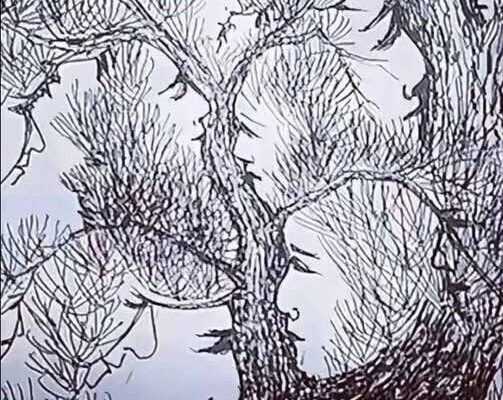Have you ever stood in front of a tree and suddenly noticed what looked like a face peering back at you from the bark? Maybe a pair of eyes in a knot, a nose outlined by cracks, or a sly smile traced in twisting vines? This captivating phenomenon is called pareidolia, a psychological quirk where our brain instinctively detects familiar shapes, especially human faces, in otherwise random or abstract patterns.
Pareidolia is more than a mere optical trick; it’s a deeply rooted survival mechanism. Our ancestors evolved to rapidly recognize faces for social interaction, to detect threats, and to build connections. Even today, this ingrained skill can make us see shapes in clouds, animals in rock formations, or figures in the moon’s surface. It’s a reminder that our mind is constantly searching for familiarity and meaning—even where none was intentionally placed.
In the world of art, pareidolia is not just a random occurrence—it’s a powerful tool. One striking example is a mesmerizing tree illusion artwork that cleverly embeds human profiles within its intricate tangle of branches, leaves, and bark textures. At first glance, you might see nothing more than a beautiful, sprawling tree. But the longer you look, the more the hidden faces begin to reveal themselves, as if the tree itself were slowly sharing its secrets.
Artists who master this technique intentionally sculpt subtle shapes resembling eyes, noses, and mouths out of natural curves and negative space. The viewer’s brain then “fills in” the missing pieces, transforming mere lines and shadows into distinct personalities. This approach blurs the line between nature and imagination, turning a simple tree into a living tapestry of hidden stories and emotions.
If you take your time with this illusion, you’ll start to spot specific characters: two lovers nestled close together within the trunk, sharing a quiet embrace; wise elders whose serene profiles appear high among the branches, like silent guardians watching over the forest; playful children whose mischievous faces peek out from knots and roots, reminding us of innocence and wonder. Each face is carefully designed to emerge slowly, rewarding patience and careful observation.
What’s especially fascinating is that no two viewers will have exactly the same experience. Someone might see a smiling woman where another sees a thoughtful old man, or a curious animal hidden behind the leaves. This subjectivity makes each encounter with the artwork deeply personal and almost interactive.
Beyond the visual delight, these illusions also remind us of the mysterious beauty that exists all around us—if only we slow down and pay attention. Trees, rocks, clouds, even a shadow cast on a wall can transform into entire hidden worlds when we allow our imagination to roam freely.
So the next time you’re out for a walk and find yourself gazing at a tree, take a moment to really look. You might discover an entire community of hidden faces watching you back, whispering stories of love, wisdom, and playfulness through their silent, secret expressions. This magical experience highlights not only the artist’s creativity but also the incredible, pattern-seeking power of the human mind—a gift that turns even the simplest moments into sources of wonder and connection.



